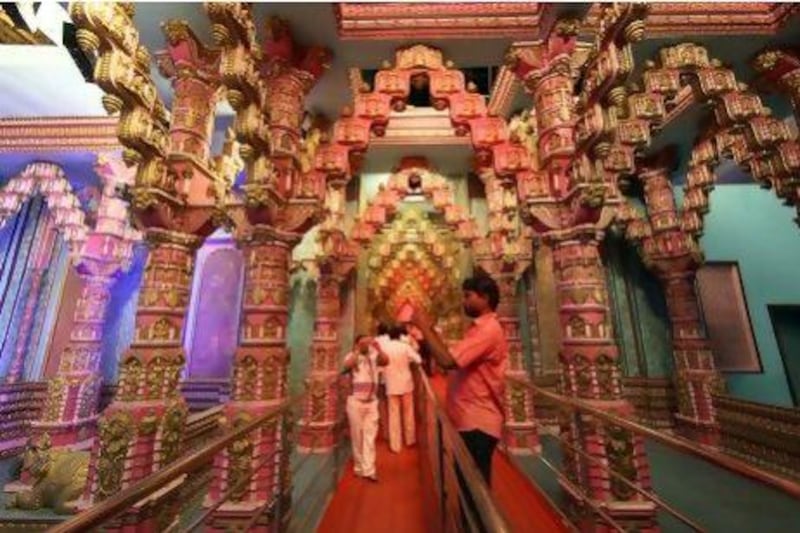HYDERABAD // Three years ago, when Sohan Roy, the director of Dam 999, examined the script for his 3-D movie, he realised that it needed a complex shooting schedule.
The movie, which traces the disastrous consequences of a leaking dam, required not only dam miniatures and pump-room sets but also underwater shots, sets depicting the interiors of a ship, village streets and cityscapes, hundreds of extras to serve as corpses, and tricky special-effects sequences.
Mr Roy, a Sharjah-based marine engineer by day, could find only one facility that met the requirements: Ramoji Film City in Hyderabad, where he shot 40 per cent of Dam 999.
Mr Roy said that Ramoji is "a dreamland for any serious filmmaker in India".
Founded in 1995, on nearly 800 hectares of gently rolling land an hour outside of Hyderabad, Ramoji is, according to Guinness World Records, the world's largest integrated film studio.
Ramoji's record may soon be in jeopardy, however, as the Prayag Group is building a 10 billion rupees (Dh659 million) complex near Kolkata, which will cover about 1,100 hectares.
Ramoji Film City's founder, the media baron Ramoji Rao, had wanted a facility where "a producer can walk in with a script and walk out with a can of film", said AV Rao, the vice-president of publicity at the studio complex.
It comes equipped with 47 soundstages, hotels, a dozen power substations, prop warehouses, post-production studios and preview theatres.
But over the past few years, Ramoji has undergone a change of character.
About 60 per cent of its revenue comes from tourism - from the million-odd people who tour Ramoji in red buses to spend the day in its food courts, visit its sets and watch stunt shows.
"We had expected to make most of our money from film shoots, with tourism as a spin-off," Mr Rao said. "Now it's almost the other way around."
In its early years, Ramoji had attracted Hollywood producers working on enjoyably cheesy B-movies: Crocodile 2, for instance, or Centipede or Nightfall. But soon after the September 11 attacks on the United States, the number of such foreign projects dwindled, as it became more of a challenge for foreign crews to obtain shooting clearances.
The increasing reliance of films on digital production has also weakened the demand for Ramoji's diverse array of sets, although, as Mr Rao said, "How many such digitally made movies can you see? At the end of the day, Indian movies need emotion."
Hundreds of film and television crews still come to Ramoji every year, their projects adding to the 1,800-odd movies that have been shot here.
In the street just outside Mr Rao's window, for example, Shah Rukh Khan shot scenes for his blockbuster Ra. One, which was released last year.
Another Bollywood superstar, Hrithik Roshan, had just finished shooting part of his science-fiction film Krrish 3 at Ramoji. The film's producers had flown in from Mumbai to shoot on a set resembling a typical Mumbai street.
"After all, for somebody like Hrithik Roshan, it's difficult to shoot in Mumbai without being mobbed," Mr Rao said with a smile.
When film crews are not swarming over them, Ramoji's sets have an eerie, ghost-town quality.
South Town, built to resemble a typical town in southern India, has posters in Tamil, signboards in Telugu, and a trash bin with "Municipal Corporation of Greater Mumbai" stencilled on it.
There is also a North Down, around the corner from what Pavan Kumar, a young communications officer at Ramoji, called a "flex house".
"It's a house with a different facade on each side," he said. "So from one side, it can be the hero's house, from another side the heroine's, from a third side an office, and from a fourth side the villain's house."
Other buildings can be similarly diverse. The rear of the airport is a mock-up of the entrance to a hospital, and the railway-station set is urban on one side and rural on the other.
Ramoji is also structured to satisfy the unique demands of Indian films.
There are elaborate gardens for song sequences, temples, mosques and several prisons - "because in our movies, people are often shown being taken from one jail to another", Mr Kumar said with a laugh.
The complex also boasts a suicide point. "This is where heroes and heroines go to jump off, when their hearts are broken," Mr Kumar said.
The thickest crowds in Ramoji are always at the stunt shows: hundreds of people sitting in an amphitheatre with a roof, watching stuntmen enact the rough-and-tumble antics of a Western.
In the audience, Iftikhar Mohammed found himself lapping it up. A taxi-service driver in Hyderabad, Mr Mohammed found the price of admission for his family of four - 600 rupees an adult and 500 rupees for each of his children - steep but well worth it.
"You see a lot of movies, and you get curious about how they're made," Mr Mohammed said. "This is a great way to find out."
[ ssubramanian@thenational.ae ]
Follow
The National
on
[ @TheNationalUAE ]
& Samanth Subramanian on
[ @Samanth_S ]





